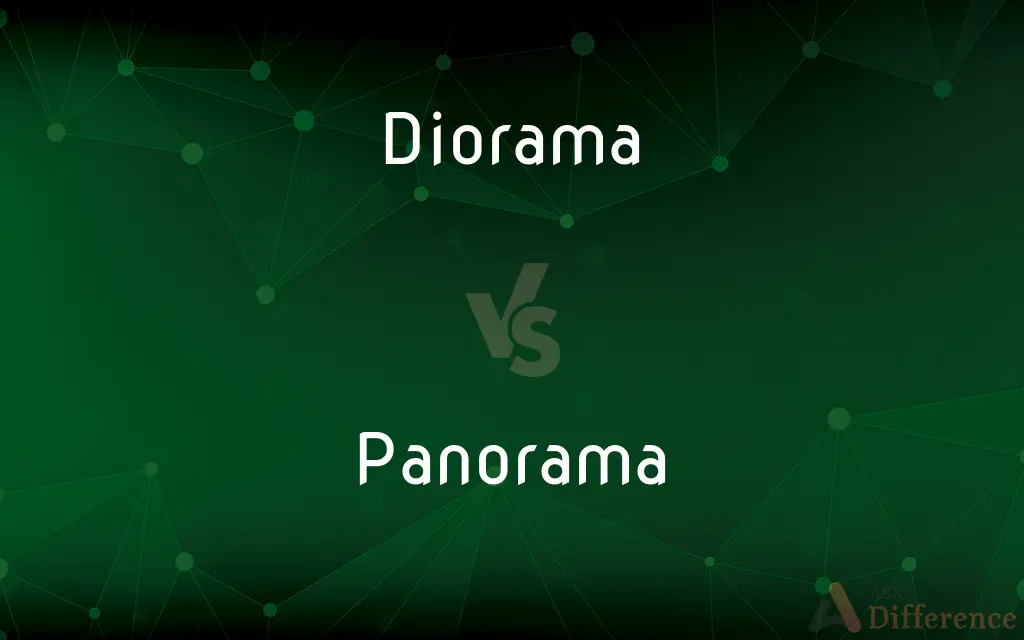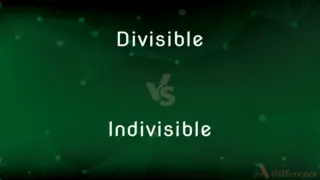Diorama vs. Panorama — What's the Difference?
By Fiza Rafique & Maham Liaqat — Updated on March 11, 2024
A diorama presents a three-dimensional model scene, often miniature, for education or entertainment, whereas a panorama is a wide, unbroken view or image of a landscape.

Difference Between Diorama and Panorama
Table of Contents
ADVERTISEMENT
Key Differences
Dioramas are three-dimensional full-scale or miniature models depicting a scene from nature, history, or fiction. They are designed to represent a specific moment in time, providing a detailed and immersive view of the scene from a particular vantage point. On the other hand, panoramas offer a broad, comprehensive view of a landscape or scene, capturing its vastness in a single, wide image or representation. Panoramas can be photographic, painted, or digitally created, focusing on delivering an expansive perspective.
In terms of presentation, dioramas often include detailed figures, landscapes, and objects within a contained space, such as a box or a room, where lighting and perspective are carefully controlled to enhance realism. Whereas panoramas, especially photographic or painted, are presented in wide formats, including circular or 360-degree views, to encompass as much of the surrounding landscape as possible, emphasizing scope over detail.
Dioramas serve various educational and entertainment purposes, from museum exhibits that teach about historical events, natural history, and cultural scenes, to hobbyist displays in model railroading and gaming. Panoramas, conversely, are frequently used in art, photography, and virtual reality to convey the grandeur of landscapes, cityscapes, or panoramic scenes, offering viewers a sense of immersion without focusing on a specific narrative moment.
The creation process of dioramas involves meticulous detail work, including sculpting, painting, and model-making, to achieve a realistic depiction of the scene. Panoramas, particularly photographic ones, require techniques such as stitching multiple images together or using wide-angle lenses to capture a comprehensive view of the scene, focusing more on capturing or creating a wide perspective than on modeling details.
While dioramas are interactive, allowing viewers to engage with the scene from a specific viewpoint and often in a more intimate setting, panoramas provide a passive viewing experience, where the emphasis is on absorbing the entirety of the view. Both forms offer unique ways to experience and understand spaces and narratives, with dioramas focusing on detailed, narrative-driven representation and panoramas on expansive, environmental perspectives.
ADVERTISEMENT
Comparison Chart
Dimensionality
Three-dimensional
Two-dimensional (with 3D effect in VR)
Scope
Specific scene or moment
Wide, comprehensive view
Presentation
Contained, detailed model
Broad, often circular or wide image
Purpose
Education, entertainment, hobby
Art, photography, VR
Creation Process
Model-making, sculpting, painting
Stitching images, wide-angle photography
Compare with Definitions
Diorama
A miniature three-dimensional model representing a scene with lifelike detail.
The museum's diorama of the Jurassic period featured realistic dinosaurs and landscapes.
Panorama
A wide-angle photograph capturing an expansive landscape.
His panorama of the Grand Canyon captured its vast beauty.
Diorama
A detailed physical recreation of a historical event for educational purposes.
The battlefield diorama accurately depicted the soldiers' positions during the Civil War.
Panorama
A broad, comprehensive view of a physical space.
From the mountaintop, the hikers enjoyed a breathtaking panorama of the valley.
Diorama
A tool for storytelling or representation in educational settings.
Students built a diorama to showcase their understanding of the ecosystem.
Panorama
A continuous pictorial representation of a landscape or scene.
The artist painted a panorama of the city's skyline.
Diorama
An exhibit in a box or enclosed space showing a scene from nature.
The rainforest diorama included model animals, plants, and sounds.
Panorama
An extended unbroken view or image, often used in photography and art.
The panoramic painting displayed the entire battle scene.
Diorama
A hobbyist's model, such as in model railroading, showing a scene or environment.
She created a diorama of a bustling 19th-century train station.
Panorama
A 360-degree view created through stitching together multiple images.
The virtual tour offered a panorama of the ancient ruins.
Diorama
The word diorama can either refer to a 19th-century mobile theatre device, or, in modern usage, a three-dimensional full-size or miniature model, sometimes enclosed in a glass showcase for a museum. Dioramas are often built by hobbyists as part of related hobbies such as military vehicle modeling, miniature figure modeling, or aircraft modeling.In the United States around 1950 and onward, natural history dioramas in museum became less fashionable, leading to many being removed, dismantled or destroyed.
Panorama
A panorama (formed from Greek πᾶν "all" + ὅραμα "sight") is any wide-angle view or representation of a physical space, whether in painting, drawing, photography, film, seismic images or a three-dimensional model. The word was originally coined in the 18th century by the English (Irish descent) painter Robert Barker to describe his panoramic paintings of Edinburgh and London.
Diorama
A three-dimensional miniature or life-size scene in which figures, stuffed wildlife, or other objects are arranged in a naturalistic setting against a painted background.
Panorama
An unbroken view of an entire surrounding area.
Diorama
A scene reproduced on cloth transparencies with various lights shining through the cloths to produce changes in effect, intended for viewing at a distance through an aperture.
Panorama
A comprehensive presentation; a survey
A panorama of American literature.
Diorama
A three-dimensional display of a scenery, often having a painted background in front of which models are arranged, e.g. in a museum where stuffed animals are presented against a painted landscape.
Panorama
A picture or series of pictures representing a continuous scene, often exhibited a part at a time by being unrolled and passed before the spectator.
Diorama
A mode of scenic representation, invented by Daguerre and Bouton, in which a painting is seen from a distance through a large opening. By a combination of transparent and opaque painting, and of transmitted and reflected light, and by contrivances such as screens and shutters, much diversity of scenic effect is produced.
Panorama
A mental vision of a series of events.
Diorama
A building used for such an exhibition.
Panorama
An unbroken view of an entire surrounding area.
Diorama
A picture (or series of pictures) representing a continuous scene
Panorama
A picture or series of pictures representing a continuous scene.
Panorama
(figuratively) A comprehensive survey.
Panorama
A complete view in every direction.
Panorama
A comprehensive survey of a particular topic; also, a broad view of the development of a series of events.
Panorama
A picture presenting a view of objects in every direction, as from a central point.
Panorama
A picture representing scenes too extended to be beheld at once, and so exhibited a part at a time, by being unrolled, and made to pass continuously before the spectator.
Panorama
The visual percept of a region;
The most desirable feature of the park are the beautiful views
Panorama
A picture (or series of pictures) representing a continuous scene
Common Curiosities
What is the main difference between a diorama and a panorama?
A diorama is a three-dimensional, detailed model scene, while a panorama is a wide, often panoramic view or image of a landscape.
Can dioramas be interactive?
Yes, dioramas can be interactive, especially in educational settings where viewers can engage with the model to learn more about the depicted scene.
Are dioramas only found in museums?
While dioramas are popular in museums, they are also used in educational settings, by hobbyists, and in various forms of entertainment and storytelling.
What materials are used to create dioramas?
Dioramas are made using a variety of materials, including plastic, wood, paper, and natural elements, depending on the desired level of detail and realism.
What skills are required to create a diorama?
Creating a diorama requires skills in model-making, painting, sculpting, and an eye for detail to accurately depict the scene.
How do panoramas capture comprehensive views?
Panoramas capture comprehensive views through techniques like wide-angle photography, stitching multiple images together, or painting expansive scenes.
Why are panoramas popular in photography and art?
Panoramas are popular because they capture the grandeur and vastness of landscapes and scenes in a way that immerses the viewer in the environment.
Can a panorama be three-dimensional?
Traditional panoramas are two-dimensional, but virtual reality technologies allow for the creation of immersive, three-dimensional panoramic experiences.
Do dioramas always represent real scenes?
No, dioramas can depict fictional scenes, imagined landscapes, or fantasy settings, as well as real historical or natural scenes.
Can panoramas include urban landscapes?
Yes, panoramas can depict any expansive scene, including urban landscapes, city skylines, and architectural panoramas.
What makes a good diorama?
A good diorama effectively conveys a story or scene through detailed models, realistic landscapes, and careful attention to lighting and perspective.
How do photographers create panoramic images?
Photographers create panoramic images by taking multiple photos across a wide scene and stitching them together digitally to form a cohesive wide-angle view.
Can panoramas be interactive?
Yes, especially with the advent of virtual reality, panoramas can be interactive, allowing viewers to explore the scene in a more immersive manner.
How long have dioramas and panoramas been around?
Both dioramas and panoramas have been around since the 19th century, evolving with technology and artistic practices over time.
Are there digital versions of dioramas?
Yes, digital technologies allow for the creation of virtual dioramas, which can be explored through computer interfaces or virtual reality, offering a modern twist on the traditional format.
Share Your Discovery

Previous Comparison
Philosophy vs. Metaphysics
Next Comparison
Divisible vs. IndivisibleAuthor Spotlight
Written by
Fiza RafiqueFiza Rafique is a skilled content writer at AskDifference.com, where she meticulously refines and enhances written pieces. Drawing from her vast editorial expertise, Fiza ensures clarity, accuracy, and precision in every article. Passionate about language, she continually seeks to elevate the quality of content for readers worldwide.
Co-written by
Maham Liaqat














































